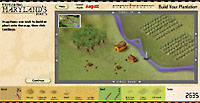
Build Your Plantation
http://mdroots.thinkport.org/interactives/plantation/
- Background/Introduction
- Seasons/Months
- Points/Score
- Game Levels/Turns
- The Land
- Game Objects
- Tools
- Random Events
Background/Introduction
|
“Their coming thus to seate upon an Indian Towne, where they found ground cleered to their hands, gave them opportunity (although they came late in the yeere) to plant some Corne, and to make them gardens, which they sowed with English seeds of all sorts, and they prospered exceeding well.” — Jerome Hawley and John Lewger, 1635,
in an advertisement to lure English people to the Maryland colony. |
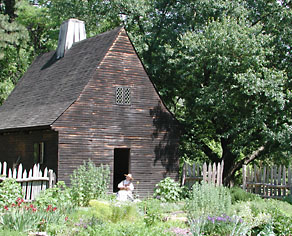 Courtesy of Historic St. Mary's City 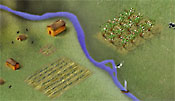 What will your plantation look like? |
This was the promise, but the realities were much harsher. Many of the first English settlers never survived their first year in Maryland. Those who did survive faced tough conditions and lots of very hard work. They had to build a house from the trees standing on their own land. They had to grow their own food and collect their own water. And almost all newcomers got sick from new kinds of diseases.
Maryland colonists discovered a place completely different from what they were used to in England. They could hardly believe the size of the trees, the width of the rivers, and the beauty of the landscape. Their hope and challenge was to succeed in this amazing and unfamiliar land.
The Build Your Plantation game is all about making the right choices to survive and prosper in the rough conditions of early Maryland. As you play the game there are certain things you can do, such as placing a house or using the axe, that can change your score and your chance of success. There are also random events, such as good or bad weather, that either add or take away points from your score. At the end of each turn, a window will open showing how many points you've earned from your plantation.
This document will help you understand the setup and rules of the game.
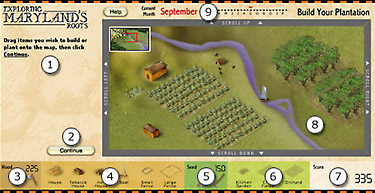
Overview
The image above shows the game layout. Numbers correspond to the descriptions below.
- Information Window. This area will give you feedback on your actions, such as wood points you've used to build a house. It will also tell you the results of random events, like when a heavy snow falls.
- Continue. Use this button to step to the next turn in the game when you have finished placing objects on the map for the current turn.
- Wood Points. This number indicates your wood points. Use the axe to get more.
- Items to Build. Build these items by dragging them onto the map. You can only build an item if you have enough wood points.
- Seed Points. This number indicates your wood points. Use the weeding hoe to get more seed in small increments, or the hilling hoe for bigger increments.
- Items to Plant. Plant these items by dragging them onto the map. You can only plant an item if you have enough seed points.
- Score. This is your total score.
- Map. Drag items onto this map to build or plant them. When events occur, you will see them in the map view. Use the bars on each side of the map to scroll around and see more of the land.
- Timeline. The current month is shown here, along with a timeline showing your entire first year in Maryland. The red arrow indicates how far you've made it.
Seasons/Months
| Spring | March, April, May The game begins in March, which is when the very first colonists arrived in Maryland from England in 1634. Spring was a good time to build houses, prepare fields, and begin planting crops. Livestock often got stuck in the marshes during the rainy spring months. |
| Summer | June, July, August Planting, tending, and weeding crops took most of a farmer's time during the summer months. This was also the most likely time for newcomers to get sick. |
| Fall | September, October, November Crops were harvested and prepared for market in the fall. Transplanting fruit trees into the orchard was also a fall activity. |
| Winter | December, January, February Farmers used the winter months to clear land and build fences for the next growing season. |
Points/Score
| Score | Your score is calculated for every action that takes place, such as placing a house or field, or in the event of disaster. |
| Wood Points | Wood points are needed as the building blocks for any wooden item. You cannot build anything without first having enough wood points. |
| Seed Points | Seed points are needed as the building blocks for any crop field or garden. You cannot plant anything without having enough seed points. |
| Bonus Points | At the end of each turn, special bonus points are added to your score. The choices you make in the game and how well you manage your resources help determine the number of bonus points you are awarded at each turn. |
Game Levels/Turns
| Game Levels | The Build Your Plantation game has three levels of difficulty — easy, normal, and hard. At the Easy game level, the year is divided into 12 turns, each representing a month. There is less chance of random disaster at this level, and you begin with more wood and seed points.
At the Easy game level, the year is divided into 12 turns, each representing a month. There is less chance of random disaster at this level, and you begin with more wood and seed points.The Normal level divides one year into 24 turns. There are two turns in each month. The Hard setting has 48 turns or four turns each month. Since random events can occur at the end of each turn, there's a greater chance for disaster to strike at this level. You also begin with less wood and seed points. To begin the game, choose a difficulty level from the pull-down menu and then press the Start button. |
| Continue |
|
| End of Game | Your goal is to gain as many points as you can in your first year in Maryland. At the end of a year your final score is calculated. Special end-of-game bonus points are awarded based on how well you managed your resources throughout the year. |
The Land
| River |
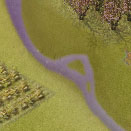 Settlers lived on scattered plots of land along the sides of rivers and creeks. It was important to be close to navigable water so they would have access to the ships that transported their crops to England. The same ships also brought necessary supplies, such as clothing, shoes, and tools.
Settlers lived on scattered plots of land along the sides of rivers and creeks. It was important to be close to navigable water so they would have access to the ships that transported their crops to England. The same ships also brought necessary supplies, such as clothing, shoes, and tools.As you place objects on your land, consider whether or not it makes sense for the item to be in, near, or far from the river. |
| Forest |
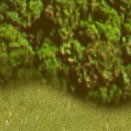 Forests provided firewood for heat and cooking, and wood for building houses and fences. Livestock found their own food in the forest. Most cows had horns and most pigs had tusks so they could defend themselves against predators in the woods.
Forests provided firewood for heat and cooking, and wood for building houses and fences. Livestock found their own food in the forest. Most cows had horns and most pigs had tusks so they could defend themselves against predators in the woods.Land with lots of trees wasn't good for growing crops, however. Since cutting down trees to clear forests was difficult, farmers girdled the trees. This meant they used an axe to strip a piece of bark all around the tree so that the sap could not rise. The trees eventually died and lost their leaves allowing sunlight to reach the ground. It could take a very long time to clear a forest this way, but girdling was quicker than chopping the trees down. As you place objects on your land, consider whether or not it makes sense for them to be in, near, or far from the forest. |
| Hills |
 Land in the Chesapeake Bay area was mostly flat, but some gentle hills did exist. Hilly terrain increased as you headed away from the shore. Plantations that did have hills took advantage of them by planting some of their crops on higher ground to protect against floods and heavy rains. Buildings placed on hills might stay drier in floods.
Land in the Chesapeake Bay area was mostly flat, but some gentle hills did exist. Hilly terrain increased as you headed away from the shore. Plantations that did have hills took advantage of them by planting some of their crops on higher ground to protect against floods and heavy rains. Buildings placed on hills might stay drier in floods.As you place objects on your land, consider whether or not it makes sense for them to be on, near, or far from hills. |
| Marsh |
 There were more than 3 million acres of wetlands in the Chesapeake Bay during colonial times-more than twice what remains today. Farmers worried about planting their crops near marshes because they might be flooded. They also needed to keep in mind that the mosquitoes that carried diseases like malaria thrived in the marshy areas.
There were more than 3 million acres of wetlands in the Chesapeake Bay during colonial times-more than twice what remains today. Farmers worried about planting their crops near marshes because they might be flooded. They also needed to keep in mind that the mosquitoes that carried diseases like malaria thrived in the marshy areas.As you place objects on your land, consider whether or not it makes sense for them to be in, near, or far from the marsh. |
| Cleared Land |
 Every plantation needed as much as 15 acres of cleared land to grow their corn and tobacco. It could take one person a month to clear one acre of forest. If they girdled the trees first they could do it in about half the time.
Every plantation needed as much as 15 acres of cleared land to grow their corn and tobacco. It could take one person a month to clear one acre of forest. If they girdled the trees first they could do it in about half the time.The Yaocomaco Indians left the settlers of St. Mary's City some cleared, fertile land ready for homes and crops. Since clearing trees from land was very difficult and took a lot of time, this gift from the native people helped make the colonist's first year successful. As you place objects on your land, consider it makes sense for them to be on cleared land or not. |
Game Objects
| House |
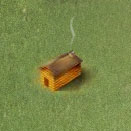 Seventeenth-century plantation houses in Maryland were one- or two-room structures made out of wood. They usually included a sleeping loft overhead. There was only one hearth in the "hall" where they cooked, ate, sat, and slept. The other room was the "kitchen" where they prepared food. A chimney usually stood between the two rooms.
Seventeenth-century plantation houses in Maryland were one- or two-room structures made out of wood. They usually included a sleeping loft overhead. There was only one hearth in the "hall" where they cooked, ate, sat, and slept. The other room was the "kitchen" where they prepared food. A chimney usually stood between the two rooms. The boards that enclosed the houses shrank as they dried. The colonists were constantly plugging the gaps with clay to keep out the wind and cold. Their roofs often leaked and the amount of tar needed to seal the houses created a major fire hazard. As a result, the houses rotted and decayed after just 15 or 20 years. Only one house from 17th century Maryland still stands today. Even wealthy people lived in houses like this. They might have had windows with glass instead of wooden shutters, brick chimneys instead of chimneys made of wattle and daub (mud and sticks), and wooden floors instead of well-packed dirt. A successful farmer might add a room, but was just as likely to build a second house for more space. |
| Tobacco House |
 Tobacco needed to hang in a tobacco house for five or six weeks before it was ready to pack and ship to England. These tobacco houses were usually made of wood. There were beams across the width of the house where bundles of tobacco were hung to cure. The weather outside had a big impact on how well the tobacco cured. If it was too wet or too dry outside, the process could take longer and affect the quality of the harvest. A leaky tobacco house could ruin the crop.
Tobacco needed to hang in a tobacco house for five or six weeks before it was ready to pack and ship to England. These tobacco houses were usually made of wood. There were beams across the width of the house where bundles of tobacco were hung to cure. The weather outside had a big impact on how well the tobacco cured. If it was too wet or too dry outside, the process could take longer and affect the quality of the harvest. A leaky tobacco house could ruin the crop. |
| Hen House |
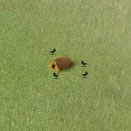 Chicken and eggs were an important food source on plantations. Chickens probably roamed free during the day to forage for food and then returned to their hen house each evening.
Chicken and eggs were an important food source on plantations. Chickens probably roamed free during the day to forage for food and then returned to their hen house each evening. |
| Boat |
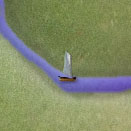 A wooden boat helped transport the crops from a farmer's land to the ships travelling to and from England. Since the early colonists didn't have horses, boats were also a way to travel to neighboring plantations. They probably used them for fishing as well.
A wooden boat helped transport the crops from a farmer's land to the ships travelling to and from England. Since the early colonists didn't have horses, boats were also a way to travel to neighboring plantations. They probably used them for fishing as well. |
| Small Fence |
 Farmers fenced in their gardens to prevent hogs from rooting under them. English gardening books from the 17th century suggest that garden fences be six to seven feet high to keep out chickens and Chesapeake deer.
Farmers fenced in their gardens to prevent hogs from rooting under them. English gardening books from the 17th century suggest that garden fences be six to seven feet high to keep out chickens and Chesapeake deer. |
| Large Fence |
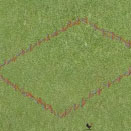 Farmers fenced in their crops, not their animals, until well into the 18th century. Planters usually used the "worm" fence for orchards and for fields of tobacco and corn. Because they weren't dug into the ground, these fences could be moved as farmers moved their fields. Worm fences were made from nine- to 14-foot split rails. It took 7 or 8 rails for a 5 or 6 foot high fence to keep animals out. A typical plantation might need more than 4000 nine-foot rails to fence in the crops, gardens, and orchard. These fences were routinely inspected and repaired.
Farmers fenced in their crops, not their animals, until well into the 18th century. Planters usually used the "worm" fence for orchards and for fields of tobacco and corn. Because they weren't dug into the ground, these fences could be moved as farmers moved their fields. Worm fences were made from nine- to 14-foot split rails. It took 7 or 8 rails for a 5 or 6 foot high fence to keep animals out. A typical plantation might need more than 4000 nine-foot rails to fence in the crops, gardens, and orchard. These fences were routinely inspected and repaired. |
| Kitchen Garden |
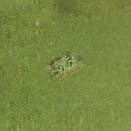 In addition to greens and berries that grew wild in Maryland, farmers planted seasonal fruits and vegetables for food. A typical kitchen garden might include melons, cabbages, onions, cucumbers, herbs, peas, beans, and root vegetables such as sweet potatoes and carrots. These gardens were fenced in to protect them from animals. Kitchen gardens produced fresh fruits and vegetables from spring through early fall. Some crops were stored for winter in a root cellar under the hearth.
In addition to greens and berries that grew wild in Maryland, farmers planted seasonal fruits and vegetables for food. A typical kitchen garden might include melons, cabbages, onions, cucumbers, herbs, peas, beans, and root vegetables such as sweet potatoes and carrots. These gardens were fenced in to protect them from animals. Kitchen gardens produced fresh fruits and vegetables from spring through early fall. Some crops were stored for winter in a root cellar under the hearth. |
| Crop Fields |
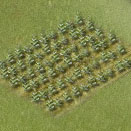 There were two basic crops that every farmer grew to survive and succeed in Maryland — corn and tobacco.
There were two basic crops that every farmer grew to survive and succeed in Maryland — corn and tobacco. Corn provided food. Maryland colonists ate baked corn bread or fried corn cakes at almost every meal. Farmers could grow twice as much food per acre by planting corn than they could with wheat, oats, or other grains. Most plantations grew about 2 acres of corn per person. One acre produced 15 to 20 bushels or three to four barrels of shelled corn. The annual ration of corn was about three barrels per person. Farmers could sell or store any extra corn they grew. Tobacco was as valuable as money to the colonists. Most Maryland colonists made their living by growing tobacco. They could sell or trade their tobacco for necessary supplies like clothes, shoes, medicine, soap, and tools that came from England. Growing tobacco took more time than any other crop and required some work nearly year-round. A typical plantation might harvest 6000 tobacco plants a year. In this game, you will only plant tobacco crop fields. Your food will come from your garden. |
| Orchard |
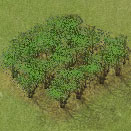 The orchard provided pears, peaches and apples for cider. The first year on a plantation might have been spent preparing an orchard field and growing fruit tree saplings in the kitchen garden. Once established an orchard held 70 to 100 trees on about an acre of land. But it could take years before an orchard produced fruit.
The orchard provided pears, peaches and apples for cider. The first year on a plantation might have been spent preparing an orchard field and growing fruit tree saplings in the kitchen garden. Once established an orchard held 70 to 100 trees on about an acre of land. But it could take years before an orchard produced fruit. |
Tools
| Axe |
“a plaine Souldier that can use a Pick-axe and spade, is better than five Knights.“ — Captain John Smith, 1624 |
| Weeding Hoe |
You can earn seed points in the game by using the weeding hoe during certain times of year. |
| Hilling Hoe |
You can earn seed points in the game by using the hilling hoe during certain times of year. |
Random Events
| Rain | Rain helped crops grow. And farmers had to wait for rain to plant new crops. |
| Strong storm | A strong storm could damage crops and buildings. Most houses leaked. Farmers spent a lot of time trying to patch holes in their homes and tobacco houses. |
| Flood | Floods usually happened in the rainy spring season. Buildings or crops that were too close to rivers and marshes might be damaged or even destroyed by floods. Planting or building on hills could protect farmers from floods. |
| Drought | Crops needed water to grow. A long period of time without rain meant that farmers had to carry water from the nearest freshwater stream or river. This was very difficult (even impossible). Some crops would die during a drought. |
| Snow | There was no such thing as a "snow day" in Early Maryland. A light snowfall in December, January, or February probably didn't slow a farmer down much. Snow might have caused damage to a building, fence, or boat, but the chance of that was rare. |
| Heavy snow | A heavy snow or ice storm could cause a flimsy building to collapse. Livestock might have trouble in a heavy snowstorm. And it was hard for them to keep their homes warm in extremely cold weather. Brrr! |
| Disease/“Seasoning” | During their first year in Maryland, almost everyone became sick from diseases, such as malaria, influenza, dysentery, and typhoid fever. Some people even died from these illnesses. Even if they survived the “seasoning,” most people died before reaching age 50. |
| Livestock disease | Farmers were so busy working in the crop fields that they often ignored their animals. A sick chicken, cow, or pig could easily die. They didn't have medicine or doctors to care for them. |
| Wild animal attack | Wolves could easily attack and kill the animals on a farm since they didn't have barns to protect them. Deer, rabbits, and other wild animals could ruin crops if proper fences weren't in place. |
| Livestock reproduce | How well animals like cows, pigs, and chickens did on plantations was partly due to luck. A lot could go wrong. When they survived and had babies, it was a very good thing. A farmer's family ate better when the farm animals were healthy. They could even sell live animals to neighbors if they had more than they needed for their own supply of milk, butter, eggs, beef, chicken, and pork. |
| Livestock wander | In 17th-century Maryland, pigs and cows were not kept in pens as they were in England. Instead animals foraged in the woods for food and would sometimes wander off a farmer's land. To identify his animals from those of his neighbors, a colonist marked the ears of his pigs and cows with a symbol or pattern. These earmarks were the only way for a farmer to prove that he owned a pig or cow that strayed onto someone else's land. |
| Livestock lost in the marsh | Animals sometimes got stuck or "mired" in the marshes. Farmers wouldn't always know when this happened. A mired animal could easily starve or be killed by wolves. |
| Worms attack crops | Farmers had to carefully search each plant for worms during the summer and early fall. If they didn't keep the worms under control, they could destroy a whole crop in a few days. |
| Exceptional harvest | If all went well through the spring and summer growing seasons, a lucky farmer might have a very large harvest. That meant more food and more money from selling crops. Harvesting crops meant cutting down the corn and tobacco plants and picking any fruits and vegetables in the kitchen garden. Farmers would then hang the tobacco leaves in their tobacco houses until they were ready to pack in "hogsheads" or barrels. Corn was also dried and stored. |
| Unite with nearby settlers to build mill | A mill made it possible for farmers to grind more corn faster. Without a mill, grinding corn was very tiring and boring work. It also took a lot of time. First, they had to soak the kernels in water for a few hours to soften them. Then they pounded them into meal (fine grains of corn) and sifted out the shell. A farmer ate about 4 ½ cups of cornmeal every day. |
| Crops to market | Tobacco and extra corn crops were usually packed on ships and sold to England. This was the main way that farmers made money to buy supplies, such as clothing and shoes. If they sold a lot of crops, they were more comfortable and better likely to survive the winter months. |
| Building collapses | The wooden structures that farmers built were not very stable. A strong storm or heavy snowfall could cause a building to collapse. Farmers could reuse the wood for a new building. |
| Boat sinks | A heavy rain could swamp a boat and make it sink. A hole in the boat could also make it sink. |
| Crops are damaged | Heavy rain, worms, floods, and drought were just a few of the things that could damage or ruin a crop. Crop damage was a serious problem, since farmers relied on their crops for food and to make a living. |
© 2025 Maryland Public Television. All Rights Reserved.